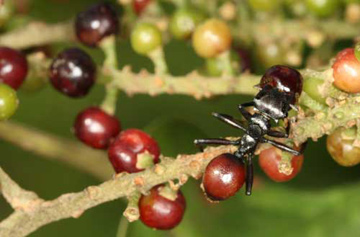Scientists have discovered a parasite that transforms the appearance of its host, an ant, into that of a juicy red berry that birds are more likely to eat and disperse into new habitats, reports an article published in The American Naturalist. It is the first example of fruit mimicry caused by a parasite, say the researchers who discovered the parasite, a nematode or roundworm found in the canopy of tropical forests ranging from Central America to the lowland Amazon.
“It’s just crazy that something as dumb as a nematode can manipulate its host’s exterior morphology and behavior in ways sufficient to convince a clever bird to facilitate transmission of the nematode,” said lead author Robert Dudley, a professor of integrative biology at the University of California, Berkeley.
 When the ant Cephalotes atratus is infected with a parasitic nematode, its normally black abdomen turns red, resembling the many red berries in the tropical forest canopy. According to researchers, this is a strategy concocted by nematodes to entice birds to eat the normally unpalatable ant and spread the parasite in their droppings. (Steve Yanoviak/University of Arkansas) |
“It’s phenomenal that these nematodes actually turn the ants bright red, and that they look so much like the fruits in the forest canopy,” added co-author Stephen P. Yanoviak, an insect ecologist and assistant professor of biology at the University of Arkansas at Little Rock.
“This is a really great example of the kinds of complex host-parasite interactions that can co-evolve, and also of the role of serendipity in tropical biology,” Dudley said.
The red berry nematode is not the only example of a parasite transforming its host. Parasitic fungi of the genus Cordyceps are known to manipulate the behavior of their ant host in order to increase their own reproductive chances. Inhaled by a passing ant, Cordyceps‘ spores grow inside the ant’s body cavity, dissolving its soft tissues but leaving vital organs intact until ihen it comes time for the fungi to reproduce. Fungal filaments grow into the brain and effectively take control of the ant’s mind, causing it to climate to the highest point of a plant and attach itself in place using its mandibles. The fungus then kills the ant sends up a fruiting body called a stroma which releases spores into the air, setting the stage for the cycle to repeat itself with another unsuspecting ant.